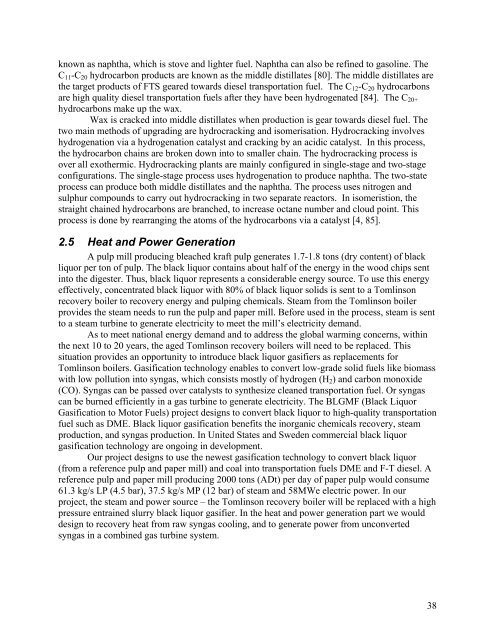Novel Design of an Integrated Pulp Mill Biorefinery for the ...
Novel Design of an Integrated Pulp Mill Biorefinery for the ...
Novel Design of an Integrated Pulp Mill Biorefinery for the ...
You also want an ePaper? Increase the reach of your titles
YUMPU automatically turns print PDFs into web optimized ePapers that Google loves.
known as naphtha, which is stove <strong>an</strong>d lighter fuel. Naphtha c<strong>an</strong> also be refined to gasoline. The<br />
C11-C20 hydrocarbon products are known as <strong>the</strong> middle distillates [80]. The middle distillates are<br />
<strong>the</strong> target products <strong>of</strong> FTS geared towards diesel tr<strong>an</strong>sportation fuel. The C12-C20 hydrocarbons<br />
are high quality diesel tr<strong>an</strong>sportation fuels after <strong>the</strong>y have been hydrogenated [84]. The C20+<br />
hydrocarbons make up <strong>the</strong> wax.<br />
Wax is cracked into middle distillates when production is gear towards diesel fuel. The<br />
two main methods <strong>of</strong> upgrading are hydrocracking <strong>an</strong>d isomerisation. Hydrocracking involves<br />
hydrogenation via a hydrogenation catalyst <strong>an</strong>d cracking by <strong>an</strong> acidic catalyst. In this process,<br />
<strong>the</strong> hydrocarbon chains are broken down into to smaller chain. The hydrocracking process is<br />
over all exo<strong>the</strong>rmic. Hydrocracking pl<strong>an</strong>ts are mainly configured in single-stage <strong>an</strong>d two-stage<br />
configurations. The single-stage process uses hydrogenation to produce naphtha. The two-state<br />
process c<strong>an</strong> produce both middle distillates <strong>an</strong>d <strong>the</strong> naphtha. The process uses nitrogen <strong>an</strong>d<br />
sulphur compounds to carry out hydrocracking in two separate reactors. In isomeristion, <strong>the</strong><br />
straight chained hydrocarbons are br<strong>an</strong>ched, to increase oct<strong>an</strong>e number <strong>an</strong>d cloud point. This<br />
process is done by rearr<strong>an</strong>ging <strong>the</strong> atoms <strong>of</strong> <strong>the</strong> hydrocarbons via a catalyst [4, 85].<br />
2.5 Heat <strong>an</strong>d Power Generation<br />
A pulp mill producing bleached kraft pulp generates 1.7-1.8 tons (dry content) <strong>of</strong> black<br />
liquor per ton <strong>of</strong> pulp. The black liquor contains about half <strong>of</strong> <strong>the</strong> energy in <strong>the</strong> wood chips sent<br />
into <strong>the</strong> digester. Thus, black liquor represents a considerable energy source. To use this energy<br />
effectively, concentrated black liquor with 80% <strong>of</strong> black liquor solids is sent to a Tomlinson<br />
recovery boiler to recovery energy <strong>an</strong>d pulping chemicals. Steam from <strong>the</strong> Tomlinson boiler<br />
provides <strong>the</strong> steam needs to run <strong>the</strong> pulp <strong>an</strong>d paper mill. Be<strong>for</strong>e used in <strong>the</strong> process, steam is sent<br />
to a steam turbine to generate electricity to meet <strong>the</strong> mill’s electricity dem<strong>an</strong>d.<br />
As to meet national energy dem<strong>an</strong>d <strong>an</strong>d to address <strong>the</strong> global warming concerns, within<br />
<strong>the</strong> next 10 to 20 years, <strong>the</strong> aged Tomlinson recovery boilers will need to be replaced. This<br />
situation provides <strong>an</strong> opportunity to introduce black liquor gasifiers as replacements <strong>for</strong><br />
Tomlinson boilers. Gasification technology enables to convert low-grade solid fuels like biomass<br />
with low pollution into syngas, which consists mostly <strong>of</strong> hydrogen (H2) <strong>an</strong>d carbon monoxide<br />
(CO). Syngas c<strong>an</strong> be passed over catalysts to syn<strong>the</strong>size cle<strong>an</strong>ed tr<strong>an</strong>sportation fuel. Or syngas<br />
c<strong>an</strong> be burned efficiently in a gas turbine to generate electricity. The BLGMF (Black Liquor<br />
Gasification to Motor Fuels) project designs to convert black liquor to high-quality tr<strong>an</strong>sportation<br />
fuel such as DME. Black liquor gasification benefits <strong>the</strong> inorg<strong>an</strong>ic chemicals recovery, steam<br />
production, <strong>an</strong>d syngas production. In United States <strong>an</strong>d Sweden commercial black liquor<br />
gasification technology are ongoing in development.<br />
Our project designs to use <strong>the</strong> newest gasification technology to convert black liquor<br />
(from a reference pulp <strong>an</strong>d paper mill) <strong>an</strong>d coal into tr<strong>an</strong>sportation fuels DME <strong>an</strong>d F-T diesel. A<br />
reference pulp <strong>an</strong>d paper mill producing 2000 tons (ADt) per day <strong>of</strong> paper pulp would consume<br />
61.3 kg/s LP (4.5 bar), 37.5 kg/s MP (12 bar) <strong>of</strong> steam <strong>an</strong>d 58MWe electric power. In our<br />
project, <strong>the</strong> steam <strong>an</strong>d power source – <strong>the</strong> Tomlinson recovery boiler will be replaced with a high<br />
pressure entrained slurry black liquor gasifier. In <strong>the</strong> heat <strong>an</strong>d power generation part we would<br />
design to recovery heat from raw syngas cooling, <strong>an</strong>d to generate power from unconverted<br />
syngas in a combined gas turbine system.<br />
38

















